Polyurethane in Automotive Filter Market
Polyurethane in Automotive Filter Market Size and Share Forecast Outlook 2025 to 2035
Polyurethane in automotive filter market is projected to grow from USD 720.0 million in 2025 to USD 1,086.4 million by 2035, at a CAGR of 4.2%. Air Filters will dominate with a 43.0% market share, while passenger cars will lead the vehicle type segment with a 62.0% share.
Polyurethane in Automotive Filter Market Forecast and Outlook 2025 to 2035
The global polyurethane in automotive filter market is projected to reach USD 1,086.4 million by 2035, recording an absolute increase of USD 360.0 million over the forecast period. The market is valued at USD 720 million in 2025 and is set to rise at a CAGR of 4.2% during the assessment period. The overall market size is expected to grow by nearly 1.5 times during the same period, supported by increasing demand for high-performance filtration materials worldwide, driving demand for durable filter technologies and increasing investments in automotive emission control and engine efficiency systems globally. The volatile raw material costs and competition from alternative filter materials may pose challenges to market expansion.
Quick Stats for Polyurethane in Automotive Filter Market
- Polyurethane in Automotive Filter Market Value (2025): USD 720 million
- Polyurethane in Automotive Filter Market Forecast Value (2035): USD 1,086.4 million
- Polyurethane in Automotive Filter Market Forecast CAGR: 4.2%
- Leading Filter Type in Polyurethane in Automotive Filter Market: Air Filters
- Key Growth Regions in Polyurethane in Automotive Filter Market: North America, Europe, and Asia Pacific
- Top Key Players in Polyurethane in Automotive Filter Market: Mann+Hummel, Donaldson, Mahle, Sogefi, Parker Hannifin, Bosch, Denso, ACDelco, UFI Filters, Hengst
- Polyurethane in Automotive Filter Market Year-over-Year Forecast (2025-2035)
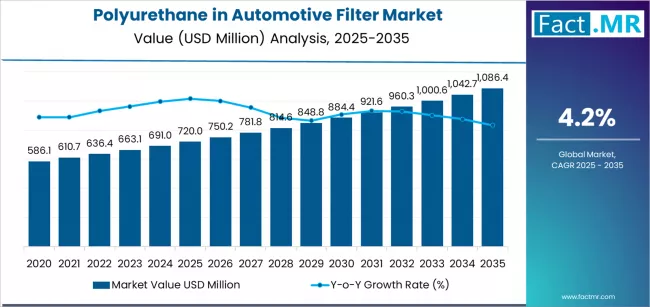
Between 2025 and 2030, the polyurethane in automotive filter market is projected to expand from USD 720.0 million to USD 880.0 million, resulting in a value increase of USD 160.0 million, which represents 44.4% of the total forecast growth for the decade. This phase of development will be shaped by rising demand for advanced filtration solutions and emission control technologies, product innovation in polyurethane formulations and filter designs, as well as expanding integration with electric vehicle platforms and hybrid powertrain systems. Companies are establishing competitive positions through investment in advanced material technologies, high-efficiency filtration solutions, and strategic market expansion across air filtration, oil filtration, and fuel system applications.
From 2030 to 2035, the market is forecast to grow from USD 880.0 million to USD 1,086.4.0 million, adding another USD 200.0 million, which constitutes 55.6% of the overall ten-year expansion. This period is expected to be characterized by the expansion of specialized polyurethane filter technologies, including eco-friendly materials and advanced filtration efficiency solutions tailored for next-generation vehicles, strategic collaborations between filter manufacturers and automotive OEMs, and an enhanced focus on circular economy principles and recyclable filter materials. The growing emphasis on emission reduction and engine longevity will drive demand for comprehensive polyurethane-based filtration solutions across diverse automotive applications.
Polyurethane in Automotive Filter Market Key Takeaways
| Metric | Value |
|---|---|
| Market Value (2025) | USD 720 million |
| Market Forecast Value (2035) | USD 1,086.4 million |
| Forecast CAGR (2025-2035) | 4.2% |
Why is the Polyurethane in Automotive Filter Market Growing?
The polyurethane in automotive filter market grows by enabling automotive manufacturers to optimize engine performance and emission control while accessing advanced filtration materials without compromising durability or efficiency requirements. Automotive OEMs and aftermarket suppliers face mounting pressure to improve filtration efficiency and extend service intervals, with polyurethane-based filters typically providing 70-80% better durability and efficiency compared to traditional filter materials, making advanced materials essential for competitive automotive positioning. The automotive industry's need for high-performance filtration and application-specific contamination control creates demand for comprehensive polyurethane solutions that can provide superior filtration efficiency, maintain consistent performance, and ensure reliable operation without compromising engine protection or emission compliance standards.
Government regulations promoting emission standards and fuel efficiency drive adoption in passenger vehicles, commercial vehicles, and aftermarket applications, where advanced filtration has a direct impact on engine performance and regulatory compliance. The material cost fluctuations and complex manufacturing processes may limit accessibility among budget-conscious consumers and regions with limited advanced manufacturing infrastructure for high-performance automotive filters.
Segmental Analysis
The market is segmented by filter type, vehicle type, and region. By filter type, the market is divided into air filters, oil filters, and fuel filters. Based on vehicle type, the market is categorized into passenger cars, light commercial vehicles, and heavy commercial vehicles. Regionally, the market is divided into North America, Europe, Asia Pacific, and other key regions.
By Filter Type, the Air Filters Segment Accounts for a Dominant Market Share
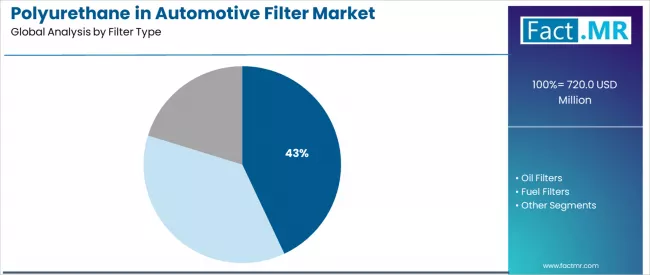
The air filters segment represents the dominant force in the polyurethane in automotive filter market, capturing approximately 43% of total market share in 2025. This established filter category encompasses systems featuring sophisticated filtration capabilities and high-efficiency particle removal, including advanced polyurethane foam structures and multi-layer designs that enable superior air filtration and engine protection across all operating conditions. The air filters segment's market leadership stems from its critical role in engine performance, with systems capable of handling diverse contamination challenges while maintaining consistent airflow and filtration efficiency across all automotive applications.
The oil filters segment maintains a substantial 34.0% market share, serving customers who require advanced lubrication system protection with enhanced contaminant removal features for engine longevity and performance optimization. These filters offer premium protection solutions for engine components while providing sufficient filtration capabilities to meet maintenance and performance demands. The fuel filters segment accounts for approximately 23.0% of the market, serving fuel system protection applications requiring specialized contamination control or performance enhancement parameters.
Key technological advantages driving the air filters segment include:
- Advanced polyurethane foam structures with optimized pore size distribution that ensure superior particle capture while maintaining airflow efficiency
- Multi-layer filtration design enabling enhanced dirt-holding capacity and extended service intervals
- Temperature-resistant formulations allowing reliable performance across extreme operating conditions without material degradation
- Enhanced durability features, extending filter life and improving overall engine protection per replacement cycle
By Vehicle Type, the Passenger Cars Segment Accounts for the Largest Market Share
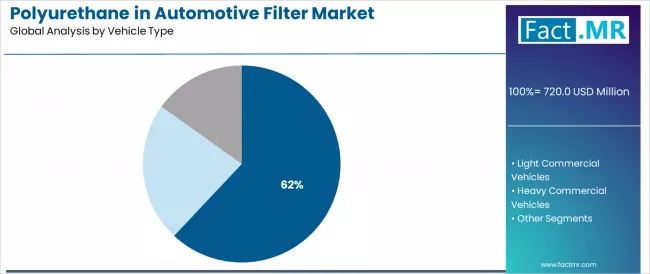
Passenger cars applications dominate the polyurethane in automotive filter market with approximately 62.0% market share in 2025, reflecting the critical role of advanced filtration in supporting global passenger vehicle operations and emission control systems worldwide. The passenger cars segment's market leadership is reinforced by increasing vehicle production volumes, emission standards requirements, and rising demand for extended maintenance intervals in personal transportation across developed and emerging markets.
The light commercial vehicles segment represents the second-largest vehicle category, capturing 25.0% market share through specialized filtration requirements for delivery vehicles, service trucks, and commercial fleet applications. This segment benefits from growing e-commerce demand and commercial transportation that requires reliable filtration systems, durability standards, and performance consistency in commercial operating environments.
The heavy commercial vehicles segment accounts for 13.0% market share, serving long-haul trucking, construction equipment, and specialized commercial applications across transportation sectors. This segment focuses on heavy-duty filtration requirements, extended service intervals, and robust performance specifications.
Key market dynamics supporting vehicle type growth include:
- Passenger car production expansion driven by global mobility trends and increasing vehicle ownership requiring advanced filtration systems in emerging markets
- Light commercial vehicle modernization trends require high-efficiency filtration systems for fleet optimization and emission compliance
- Integration of advanced powertrain technologies enabling sophisticated filtration solutions and performance monitoring systems
- Growing emphasis on vehicle longevity driving demand for intelligent, durable filtration solutions without premature replacement susceptibility
What are the Drivers, Restraints, and Key Trends of the Polyurethane in Automotive Filter Market?
The market is driven by three concrete demand factors tied to automotive performance outcomes. First, emission regulation compliance and fuel efficiency standards create increasing demand for high-performance filtration materials, with automotive filtration requirements expanding by 8-12% annually in major automotive markets worldwide, requiring comprehensive polyurethane filter infrastructure. Second, vehicle longevity and maintenance optimization initiatives drive increased adoption of advanced filter materials, with many automotive manufacturers implementing extended service interval strategies for customer satisfaction by 2030. Third, technological advancements in polyurethane chemistry and filter design enable more effective and durable filtration solutions that improve engine protection while enhancing filtration efficiency and material performance characteristics.
Market restraints include volatile raw material costs for polyurethane and specialized chemicals that can create pricing pressures for filter manufacturers, particularly in developing regions where cost sensitivity remains a primary purchasing consideration. Competition from alternative filter materials and manufacturing complexity pose additional challenges, as polyurethane processing requires specialized equipment and expertise, potentially causing increased production costs and supply chain complications. Market saturation in mature automotive markets across different regions creates additional competitive challenges for established players, demanding ongoing investment in innovation and cost optimization strategies.
Key trends indicate accelerated growth in Asian markets, particularly China and India, where automotive production expansion and emission standard implementation drive comprehensive polyurethane filter adoption. Technology integration trends toward eco-conscious polyurethane formulations with recyclable components, bio-based materials, and circular economy principles enable environmentally-conscious approaches that appeal to eco-aware consumers and regulatory requirements. The market thesis could face disruption if significant changes in automotive powertrain technologies or alternative filtration approaches reduce reliance on traditional polyurethane-based automotive filters.
Analysis of the Polyurethane in Automotive Filter Market by Key Country
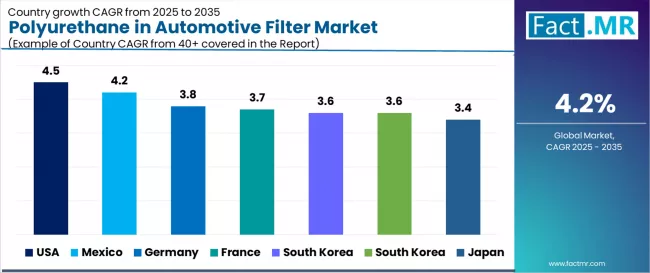
| Country | CAGR (2025-2035) |
|---|---|
| USA | 4.5% |
| Mexico | 4.2% |
| Germany | 3.8% |
| France | 3.7% |
| South Korea | 3.6% |
| UK | 3.6% |
| Japan | 3.4% |
The polyurethane in automotive filter market is gaining momentum worldwide, with the USA taking the lead thanks to stringent emission regulations and advanced automotive manufacturing initiatives. Close behind, Mexico benefits from expanding automotive production activities and NAFTA manufacturing advantages, positioning itself as a strategic growth hub in the North American automotive supply chain. Germany shows steady advancement, where integration of automotive technologies strengthens its role in the European automotive filter supply chain. France and the UK are focusing on emission compliance and automotive innovation initiatives, signaling their ambitions to capitalize on growing opportunities in the European automotive market. South Korea stands out for its automotive technology adoption in existing manufacturing and export operations, and Japan continues to record consistent progress in advanced automotive component modernization. Together, the USA and Mexico anchor the regional expansion story, while the rest build stability and diversity into the market's growth path.
The report covers an in-depth analysis of 40+ countries, with top-performing countries are highlighted below.
USA Leads Global Market Expansion
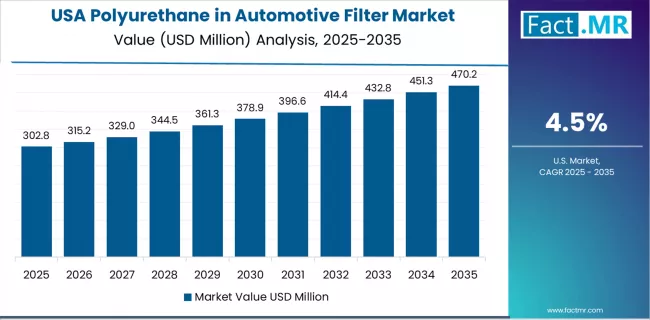
The USA demonstrates the strongest growth potential in the polyurethane in automotive filter market with a CAGR of 4.5% through 2035. The country's leadership position stems from stringent EPA emission standards, automotive manufacturing modernization, and aftermarket service demand driving the adoption of advanced filtration solutions. Growth is concentrated in major automotive centers, including Michigan, Ohio, Tennessee, and the Southeast, where automotive manufacturing facilities and aftermarket suppliers implement advanced polyurethane filter technologies for emission compliance and performance optimization. Distribution channels through automotive parts distributors and OEM partnerships expand coverage across passenger vehicle and commercial vehicle applications. The country's automotive regulatory framework provides policy support for advanced filtration adoption, including high-efficiency polyurethane filter systems.
Key market factors:
- Automotive manufacturing expansion concentrated in automotive corridors and supplier networks with comprehensive emission control programs
- Regulatory compliance requirements through EPA standards and state-level emission regulations
- Comprehensive automotive ecosystem, including established filter manufacturers with proven automotive supply chain integration
- Technology integration featuring advanced material platforms, emission control systems, and performance optimization technologies
Mexico Emerges as Strong Growth Market
In Mexico City, Guadalajara, Monterrey, and Tijuana, the adoption of polyurethane automotive filter solutions is expanding across automotive manufacturing facilities and aftermarket suppliers, driven by NAFTA manufacturing advantages and automotive industry growth. The market demonstrates strong growth momentum with a CAGR of 4.2% through 2035, linked to automotive production expansion and increasing focus on emission control solutions. Mexican automotive manufacturers are implementing polyurethane filter technologies and systems to enhance vehicle performance while meeting growing demand in expanding automotive production and export sectors. The country's automotive manufacturing growth and trade advantages create demand for advanced filtration solutions, while increasing emphasis on emission compliance drives adoption of high-performance filter material systems.
- Leading automotive expansion cities, including Mexico City, Guadalajara, Monterrey, and Tijuana, are driving polyurethane filter adoption
- Automotive manufacturing development models enabling 35% faster filter integration timelines
- Production agreements accelerating deployment with international polyurethane filter suppliers
- Trade policy support through automotive manufacturing initiatives and emission standard modernization programs
Germany Maintains Automotive Technology Leadership
The established automotive industry in Germany demonstrates sophisticated implementation of polyurethane filter solutions, with documented case studies showing 42% improvement in filtration efficiency through premium automotive manufacturing channels. The country's automotive infrastructure in major cities, including Stuttgart, Munich, Wolfsburg, and Frankfurt, showcases integration of advanced filtration technologies with existing automotive systems, leveraging expertise in precision engineering and automotive innovation. German automotive manufacturers emphasize performance and quality standards, creating demand for high-performance polyurethane filter solutions that support engineering excellence initiatives and premium vehicle positioning requirements. The market maintains steady growth through focus on automotive technology integration and performance excellence, with a CAGR of 3.8% through 2035.
Key development areas:
- Automotive manufacturing centers and supplier networks leading polyurethane filter technology adoption with comprehensive performance programs
- Automotive engineering services channels providing integrated solutions with 93% performance optimization rates
- Technology partnerships between polyurethane filter companies and German automotive manufacturers expanding market reach
- Integration of automotive filtration technologies and comprehensive performance management systems
France Shows Strong Automotive Innovation
Polyurethane in automotive filter market expansion in France is driven by diverse automotive demand, including luxury vehicles in Paris and automotive manufacturing in other major cities, and comprehensive automotive modernization across multiple regions. The country demonstrates solid growth potential with a CAGR of 3.7% through 2035, supported by automotive innovation investment programs and mobility development initiatives. French automotive companies face implementation challenges related to emission standard compliance and supply chain optimization, requiring strategic material sourcing approaches and support from international suppliers. However, growing environmental regulations and performance demands create compelling business cases for polyurethane filter adoption, particularly in automotive centers where filtration quality has a direct impact on vehicle performance and compliance.
Market characteristics:
- Luxury automotive segment showing consistent growth with 32% annual increase in polyurethane filter utilization
- Regional expansion trends focused on automotive manufacturing areas and premium vehicle centers
- Future projections indicate need for automotive technology infrastructure and filtration specialist programs
- Growing emphasis on emission compliance and performance optimization in automotive operations
United Kingdom Demonstrates Automotive Innovation
The UK market shows strength in automotive filtration innovation based on integration with advanced vehicle systems and automotive technologies for enhanced performance outcomes. The country shows steady potential with a CAGR of 3.6% through 2035, driven by the modernization of existing automotive infrastructure and the expansion of advanced vehicle platforms in major areas, including Birmingham, Coventry, London, and Manchester. British automotive companies are adopting polyurethane filter materials for performance optimization and emission compliance, particularly in regions with established automotive requirements and premium vehicle positioning demanding comprehensive filtration upgrades. Technology deployment channels through established automotive suppliers and specialty filter companies expand coverage across vehicle segments and performance applications.
Leading market segments:
- Automotive modernization projects in major manufacturing centers implementing comprehensive polyurethane filter upgrades
- Automotive partnerships with technology providers, achieving 87% emission compliance improvement rates
- Strategic collaborations between polyurethane filter suppliers and UK automotive manufacturers expanding market presence
- Focus on premium vehicle positioning and specialized performance requirements
South Korea Emphasizes Automotive Technology Integration
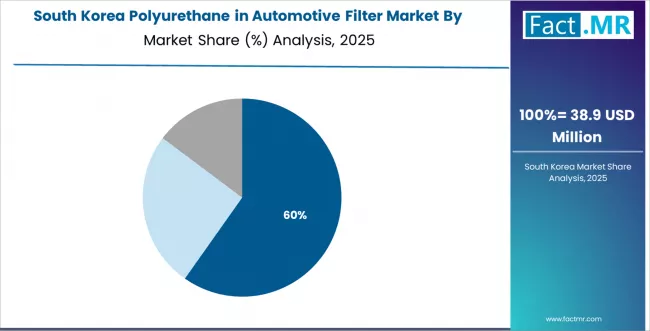
In Seoul, Busan, Incheon, and Ulsan, automotive manufacturers are implementing comprehensive polyurethane filter solutions to modernize existing vehicle production infrastructure and improve emission performance, with documented case studies showing a 38% improvement in filtration efficiency through advanced material technologies. The market shows steady growth potential with a CAGR of 3.6% through 2035, linked to ongoing modernization of automotive manufacturing, export market expansion, and emerging electric vehicle projects in major automotive centers. Korean automotive companies are adopting polyurethane filter and emission control platforms to enhance vehicle performance while maintaining quality standards demanded by the competitive automotive and export industries. The country's established automotive infrastructure creates demand for filtration upgrade and modernization solutions that integrate with existing vehicle production systems.
Market development factors:
- Automotive manufacturers and supplier networks leading polyurethane filter modernization initiatives across automotive centers
- Automotive technology modernization programs providing investment support for manufacturing and emission control infrastructure upgrades
- Strategic partnerships between Korean automotive companies and international polyurethane filter providers expanding technical capabilities
- Emphasis on export quality and emission standards compliance across automotive applications
Japan Emphasizes Precision and Automotive Excellence
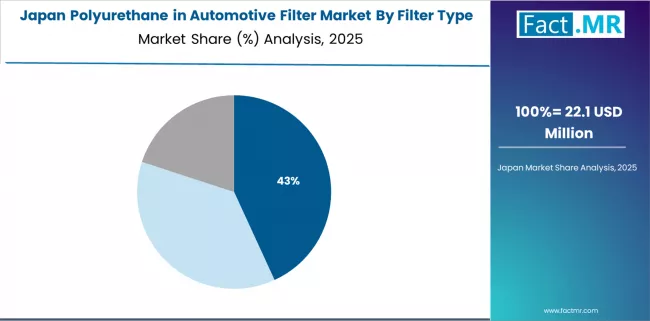
Polyurethane in automotive filter market in Japan demonstrates sophisticated implementation focused on precision manufacturing and automotive excellence optimization, with documented integration of advanced filtration systems achieving 44% improvement in filter performance across automotive manufacturing and supplier facilities. The country maintains steady growth momentum with a CAGR of 3.4% through 2035, driven by automotive manufacturers' emphasis on quality standards and precision engineering methodologies that align with automotive excellence principles applied to component selection operations. Major automotive centers, including Tokyo, Toyota City, Hiroshima, and Yokohama, showcase advanced deployment of automotive platforms where polyurethane filter systems integrate seamlessly with existing vehicle production systems and comprehensive quality management programs.
Key market characteristics:
- Automotive manufacturers and component suppliers driving premium polyurethane filter requirements with emphasis on quality and precision
- Quality management partnerships enabling 95% filter performance with comprehensive testing programs
- Technology collaboration between Japanese companies and international polyurethane filter providers expanding market capabilities
- Emphasis on precision engineering requirements and automotive excellence methodologies
Europe Market Split by Country
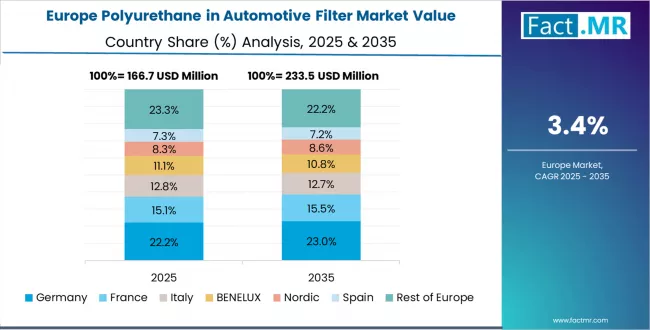
The polyurethane in automotive filter market in Europe is projected to grow from USD 210.0 million in 2025 to USD 315.0 million by 2035, registering a CAGR of 4.1% over the forecast period. Germany is expected to maintain its leadership position with a 32.1% market share in 2025, maintaining 31.8% by 2035, supported by its extensive automotive manufacturing infrastructure, advanced emission regulations, and comprehensive automotive supply chain networks serving major European markets.
The United Kingdom follows with a 18.9% share in 2025, projected to reach 19.2% by 2035, driven by comprehensive automotive modernization programs in Birmingham, Coventry, and other automotive centers implementing advanced filtration technologies. France holds a 17.6% share in 2025, expected to maintain 17.4% by 2035 through ongoing development of automotive manufacturing and supplier networks. Italy commands a 14.8% share, while Spain accounts for 9.4% in 2025. The Rest of Europe region is anticipated to gain momentum, expanding its collective share from 7.2% to 7.8% by 2035, attributed to increasing polyurethane filter adoption in Nordic countries and emerging Eastern European automotive facilities implementing emission compliance programs.
Competitive Landscape of the Polyurethane in Automotive Filter Market
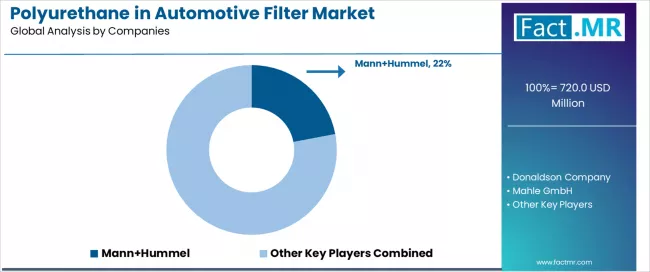
The Polyurethane in automotive filter market features approximately 20-30 meaningful players with moderate concentration, where the top three companies control roughly 32-40% of global market share through established automotive relationships and extensive manufacturing capabilities. Competition centers on filtration efficiency, durability performance, and OEM partnerships rather than price competition alone.
Market leaders include Mann+Hummel, Donaldson, and Mahle, which maintain competitive advantages through comprehensive automotive filter portfolios, global manufacturing networks, and deep expertise in the automotive OEM and aftermarket sectors, creating strong supplier relationships with vehicle manufacturers. These companies leverage established automotive partnerships and ongoing product development contracts to defend market positions while expanding into adjacent filtration and emission control applications.
Global Polyurethane in Automotive Filter Market - Stakeholder Contribution Framework
Polyurethane in automotive filter solutions represent a critical filtration technology that enables automotive manufacturers and service providers to enhance engine protection and emission compliance without compromising performance or durability requirements, typically providing 70-80% better filtration efficiency and durability compared to traditional filter materials. With the market projected to grow from USD 720.0 million in 2025 to USD 1,086.4 million by 2035 at a 4.2% CAGR, these solutions offer compelling advantages - superior filtration performance, enhanced durability, and emission compliance capabilities - making them essential for air filtration (43.0% market share), oil filtration (34.0% share), and fuel system applications seeking reliable high-performance filtration solutions. Scaling market penetration and material innovation requires coordinated action across automotive policy, industry standards, filter manufacturers, automotive OEMs, and material science research institutions.
How Governments Could Spur Local Production and Adoption?
- Automotive Innovation Programs: Include advanced filtration technologies in national automotive development initiatives, providing targeted funding for filter manufacturing facilities in automotive regions and supporting local technology companies through innovation grants and manufacturing incentives.
- Tax Policy & R&D Support: Implement accelerated depreciation schedules for automotive filter manufacturing equipment, provide tax incentives for companies investing in polyurethane material technologies, and establish favorable research accounting standards that encourage advanced filtration adoption over traditional materials.
- Regulatory Framework Development: Create standardized automotive filter certification processes across emission control and performance applications, establish clear efficiency frameworks for filtration operation, and develop international harmonization protocols that facilitate cross-border automotive filter trade.
- Skills Development & Training: Fund vocational programs for automotive filter technicians, material science specialists, and manufacturing professionals. Invest in technology transfer initiatives that bridge academic research with commercial polyurethane filter development and performance optimization systems.
- Market Access & Competition: Establish procurement policies that favor high-efficiency filtration solutions for government vehicle fleet applications, support small and medium automotive suppliers through preferential lending programs, and create regulatory environments that encourage innovation in automotive filtration technologies.
How Industry Bodies Could Support Market Development?
- Performance Standards & Certification: Define standardized efficiency metrics for polyurethane automotive filters across passenger vehicle, commercial vehicle, and aftermarket applications, establish universal durability and performance protocols, and create certification programs for filter quality that manufacturers can rely on.
- Market Education & Best Practices: Lead messaging that demonstrates polyurethane filter advantages, emphasizing improved engine protection, enhanced emission compliance, and superior durability compared to conventional filter alternatives.
- Technology Integration Standards: Develop interoperability standards for automotive filtration systems, material compatibility guidelines, and performance assessment platforms, ensuring consistent quality practices across different vehicle platforms and manufacturing requirements.
- Professional Development: Run certification programs for automotive engineers, filter technicians, and service teams on optimizing polyurethane filter performance, installation procedures, and maintenance management in automotive applications.
How Manufacturers and Automotive Players Could Strengthen the Ecosystem?
- Advanced Material Development: Develop next-generation polyurethane filter technologies with enhanced filtration capabilities, improved durability features, and eco-friendly material options that enhance automotive performance while reducing environmental impact.
- OEM Partnership Platforms: Provide comprehensive automotive integration services that integrate performance specifications, supply chain management, quality assurance, and technical support, enabling OEMs to maximize filtration effectiveness and emission compliance.
- Manufacturing & Supply Networks: Offer flexible manufacturing programs for automotive OEMs and aftermarket suppliers, including inventory management options, quality control services, and logistics pathways that keep products current with automotive production demands.
- Research & Development Networks: Build comprehensive R&D capabilities, collaborative material science programs, and application development systems that ensure polyurethane filters maintain high performance standards and automotive compatibility across diverse vehicle applications.
How Suppliers Could Navigate the Shift?
- Diversified Filter Portfolios: Expand polyurethane filter offerings across air filtration (43.0% market dominance), oil filtration (34.0% share), and fuel filter applications, with particular focus on passenger cars (62.0% vehicle share) and specialized solutions for diverse automotive requirements.
- Geographic Market Development: Establish operations in high-growth markets like the USA (4.5% CAGR) and Mexico (4.2% CAGR), while strengthening presence in established markets like Germany (3.8% CAGR) and France (3.7% CAGR) through regional manufacturing capabilities and automotive partnerships.
- Technology-Enabled Services: Implement advanced supply chain systems with real-time inventory tracking, automated quality control, and predictive demand features that differentiate service offerings and improve OEM satisfaction and performance.
- Flexible Business Models: Develop standard, premium, and custom polyurethane filter solutions that accommodate varying automotive needs, from cost-effective aftermarket applications to high-performance OEM specifications for demanding vehicle requirements.
How Investors and Financial Enablers Could Unlock Value?
- Automotive Technology Expansion Financing: Provide growth capital for established companies like Mann+Hummel, Donaldson, and Mahle to expand polyurethane filter production capacity and geographic coverage, particularly in emerging markets with growing automotive manufacturing demands.
- Innovation Investment: Back startups developing advanced polyurethane materials, eco-friendly filter technologies, and smart filtration systems that enhance automotive industry efficiency and competitive positioning.
- Regional Market Development: Finance market entry and expansion strategies for automotive filter companies establishing operations in high-growth regions, supporting localization initiatives that reduce costs while maintaining performance standards.
Key Players in the Polyurethane in Automotive Filter Market
- Mann+Hummel
- Donaldson Company
- Mahle GmbH
- Sogefi S.p.A.
- Parker Hannifin Corporation
- Robert Bosch GmbH
- Denso Corporation
- ACDelco (General Motors)
- UFI Filters
- Hengst SE
Scope of the Report
| Item | Value |
|---|---|
| Quantitative Units | USD 720 million |
| Filter Type | Air Filters, Oil Filters, Fuel Filters |
| Vehicle Type | Passenger Cars, Light Commercial Vehicles, Heavy Commercial Vehicles |
| Regions Covered | North America, Europe, Asia Pacific, Latin America, Middle East & Africa |
| Country Covered | USA, Germany, France, UK, Japan, South Korea, Mexico, and 40+ countries |
| Key Companies Profiled | Mann+Hummel, Donaldson, Mahle, Sogefi, Parker Hannifin, Bosch, Denso, ACDelco, UFI Filters, Hengst |
| Additional Attributes | Dollar sales by filter type and vehicle type categories, regional adoption trends across North America, Europe, and Asia Pacific, competitive landscape with automotive filter manufacturers and OEM partners, automotive specification requirements and performance standards, integration with emission control initiatives and automotive platforms, innovations in polyurethane material technology and filtration systems, and development of specialized applications with efficiency standards and durability capabilities. |
Polyurethane in Automotive Filter Market by Segments
-
Filter Type :
- Air Filters
- Oil Filters
- Fuel Filters
-
Vehicle Type :
- Passenger Cars
- Light Commercial Vehicles
- Heavy Commercial Vehicles
-
Region :
- North America
- United States
- Canada
- Mexico
- Europe
- Germany
- United Kingdom
- France
- Italy
- Spain
- Nordic
- BENELUX
- Rest of Europe
- Asia Pacific
- China
- Japan
- South Korea
- India
- Australia & New Zealand
- ASEAN
- Rest of Asia Pacific
- Latin America
- Brazil
- Chile
- Rest of Latin America
- Middle East & Africa
- Kingdom of Saudi Arabia
- Other GCC Countries
- Turkey
- South Africa
- Other African Union
- Rest of Middle East & Africa
- North America
Table of Content
- Executive Summary
- Global Market Outlook
- Demand to side Trends
- Supply to side Trends
- Technology Roadmap Analysis
- Analysis and Recommendations
- Market Overview
- Market Coverage / Taxonomy
- Market Definition / Scope / Limitations
- Market Background
- Market Dynamics
- Drivers
- Restraints
- Opportunity
- Trends
- Scenario Forecast
- Demand in Optimistic Scenario
- Demand in Likely Scenario
- Demand in Conservative Scenario
- Opportunity Map Analysis
- Product Life Cycle Analysis
- Supply Chain Analysis
- Investment Feasibility Matrix
- Value Chain Analysis
- PESTLE and Porter’s Analysis
- Regulatory Landscape
- Regional Parent Market Outlook
- Production and Consumption Statistics
- Import and Export Statistics
- Market Dynamics
- Global Market Analysis 2020 to 2024 and Forecast, 2025 to 2035
- Historical Market Size Value (USD Million) Analysis, 2020 to 2024
- Current and Future Market Size Value (USD Million) Projections, 2025 to 2035
- Y to o to Y Growth Trend Analysis
- Absolute $ Opportunity Analysis
- Global Market Pricing Analysis 2020 to 2024 and Forecast 2025 to 2035
- Global Market Analysis 2020 to 2024 and Forecast 2025 to 2035, By Filter Type
- Introduction / Key Findings
- Historical Market Size Value (USD Million) Analysis By Filter Type , 2020 to 2024
- Current and Future Market Size Value (USD Million) Analysis and Forecast By Filter Type , 2025 to 2035
- Air Filters
- Oil Filters
- Fuel Filters
- Y to o to Y Growth Trend Analysis By Filter Type , 2020 to 2024
- Absolute $ Opportunity Analysis By Filter Type , 2025 to 2035
- Global Market Analysis 2020 to 2024 and Forecast 2025 to 2035, By Vehicle Type
- Introduction / Key Findings
- Historical Market Size Value (USD Million) Analysis By Vehicle Type, 2020 to 2024
- Current and Future Market Size Value (USD Million) Analysis and Forecast By Vehicle Type, 2025 to 2035
- Passenger Cars
- Light Commercial Vehicles
- Heavy Commercial Vehicles
- Y to o to Y Growth Trend Analysis By Vehicle Type, 2020 to 2024
- Absolute $ Opportunity Analysis By Vehicle Type, 2025 to 2035
- Global Market Analysis 2020 to 2024 and Forecast 2025 to 2035, By Region
- Introduction
- Historical Market Size Value (USD Million) Analysis By Region, 2020 to 2024
- Current Market Size Value (USD Million) Analysis and Forecast By Region, 2025 to 2035
- North America
- Latin America
- Western Europe
- Eastern Europe
- East Asia
- South Asia and Pacific
- Middle East & Africa
- Market Attractiveness Analysis By Region
- North America Market Analysis 2020 to 2024 and Forecast 2025 to 2035, By Country
- Historical Market Size Value (USD Million) Trend Analysis By Market Taxonomy, 2020 to 2024
- Market Size Value (USD Million) Forecast By Market Taxonomy, 2025 to 2035
- By Country
- USA
- Canada
- Mexico
- By Filter Type
- By Vehicle Type
- By Country
- Market Attractiveness Analysis
- By Country
- By Filter Type
- By Vehicle Type
- Key Takeaways
- Latin America Market Analysis 2020 to 2024 and Forecast 2025 to 2035, By Country
- Historical Market Size Value (USD Million) Trend Analysis By Market Taxonomy, 2020 to 2024
- Market Size Value (USD Million) Forecast By Market Taxonomy, 2025 to 2035
- By Country
- Brazil
- Chile
- Rest of Latin America
- By Filter Type
- By Vehicle Type
- By Country
- Market Attractiveness Analysis
- By Country
- By Filter Type
- By Vehicle Type
- Key Takeaways
- Western Europe Market Analysis 2020 to 2024 and Forecast 2025 to 2035, By Country
- Historical Market Size Value (USD Million) Trend Analysis By Market Taxonomy, 2020 to 2024
- Market Size Value (USD Million) Forecast By Market Taxonomy, 2025 to 2035
- By Country
- Germany
- UK
- Italy
- Spain
- France
- Nordic
- BENELUX
- Rest of Western Europe
- By Filter Type
- By Vehicle Type
- By Country
- Market Attractiveness Analysis
- By Country
- By Filter Type
- By Vehicle Type
- Key Takeaways
- Eastern Europe Market Analysis 2020 to 2024 and Forecast 2025 to 2035, By Country
- Historical Market Size Value (USD Million) Trend Analysis By Market Taxonomy, 2020 to 2024
- Market Size Value (USD Million) Forecast By Market Taxonomy, 2025 to 2035
- By Country
- Russia
- Poland
- Hungary
- Balkan & Baltic
- Rest of Eastern Europe
- By Filter Type
- By Vehicle Type
- By Country
- Market Attractiveness Analysis
- By Country
- By Filter Type
- By Vehicle Type
- Key Takeaways
- East Asia Market Analysis 2020 to 2024 and Forecast 2025 to 2035, By Country
- Historical Market Size Value (USD Million) Trend Analysis By Market Taxonomy, 2020 to 2024
- Market Size Value (USD Million) Forecast By Market Taxonomy, 2025 to 2035
- By Country
- China
- Japan
- South Korea
- By Filter Type
- By Vehicle Type
- By Country
- Market Attractiveness Analysis
- By Country
- By Filter Type
- By Vehicle Type
- Key Takeaways
- South Asia and Pacific Market Analysis 2020 to 2024 and Forecast 2025 to 2035, By Country
- Historical Market Size Value (USD Million) Trend Analysis By Market Taxonomy, 2020 to 2024
- Market Size Value (USD Million) Forecast By Market Taxonomy, 2025 to 2035
- By Country
- India
- ASEAN
- Australia & New Zealand
- Rest of South Asia and Pacific
- By Filter Type
- By Vehicle Type
- By Country
- Market Attractiveness Analysis
- By Country
- By Filter Type
- By Vehicle Type
- Key Takeaways
- Middle East & Africa Market Analysis 2020 to 2024 and Forecast 2025 to 2035, By Country
- Historical Market Size Value (USD Million) Trend Analysis By Market Taxonomy, 2020 to 2024
- Market Size Value (USD Million) Forecast By Market Taxonomy, 2025 to 2035
- By Country
- Kingdom of Saudi Arabia
- Other GCC Countries
- Turkiye
- South Africa
- Other African Union
- Rest of Middle East & Africa
- By Filter Type
- By Vehicle Type
- By Country
- Market Attractiveness Analysis
- By Country
- By Filter Type
- By Vehicle Type
- Key Takeaways
- Key Countries Market Analysis
- USA
- Pricing Analysis
- Market Share Analysis, 2024
- By Filter Type
- By Vehicle Type
- Canada
- Pricing Analysis
- Market Share Analysis, 2024
- By Filter Type
- By Vehicle Type
- Mexico
- Pricing Analysis
- Market Share Analysis, 2024
- By Filter Type
- By Vehicle Type
- Brazil
- Pricing Analysis
- Market Share Analysis, 2024
- By Filter Type
- By Vehicle Type
- Chile
- Pricing Analysis
- Market Share Analysis, 2024
- By Filter Type
- By Vehicle Type
- Germany
- Pricing Analysis
- Market Share Analysis, 2024
- By Filter Type
- By Vehicle Type
- UK
- Pricing Analysis
- Market Share Analysis, 2024
- By Filter Type
- By Vehicle Type
- Italy
- Pricing Analysis
- Market Share Analysis, 2024
- By Filter Type
- By Vehicle Type
- Spain
- Pricing Analysis
- Market Share Analysis, 2024
- By Filter Type
- By Vehicle Type
- France
- Pricing Analysis
- Market Share Analysis, 2024
- By Filter Type
- By Vehicle Type
- India
- Pricing Analysis
- Market Share Analysis, 2024
- By Filter Type
- By Vehicle Type
- ASEAN
- Pricing Analysis
- Market Share Analysis, 2024
- By Filter Type
- By Vehicle Type
- Australia & New Zealand
- Pricing Analysis
- Market Share Analysis, 2024
- By Filter Type
- By Vehicle Type
- China
- Pricing Analysis
- Market Share Analysis, 2024
- By Filter Type
- By Vehicle Type
- Japan
- Pricing Analysis
- Market Share Analysis, 2024
- By Filter Type
- By Vehicle Type
- South Korea
- Pricing Analysis
- Market Share Analysis, 2024
- By Filter Type
- By Vehicle Type
- Russia
- Pricing Analysis
- Market Share Analysis, 2024
- By Filter Type
- By Vehicle Type
- Poland
- Pricing Analysis
- Market Share Analysis, 2024
- By Filter Type
- By Vehicle Type
- Hungary
- Pricing Analysis
- Market Share Analysis, 2024
- By Filter Type
- By Vehicle Type
- Kingdom of Saudi Arabia
- Pricing Analysis
- Market Share Analysis, 2024
- By Filter Type
- By Vehicle Type
- Turkiye
- Pricing Analysis
- Market Share Analysis, 2024
- By Filter Type
- By Vehicle Type
- South Africa
- Pricing Analysis
- Market Share Analysis, 2024
- By Filter Type
- By Vehicle Type
- USA
- Market Structure Analysis
- Competition Dashboard
- Competition Benchmarking
- Market Share Analysis of Top Players
- By Regional
- By Filter Type
- By Vehicle Type
- Competition Analysis
- Competition Deep Dive
- Mann+Hummel
- Overview
- Product Portfolio
- Profitability by Market Segments (Product/Age /Sales Channel/Region)
- Sales Footprint
- Strategy Overview
- Marketing Strategy
- Product Strategy
- Channel Strategy
- Donaldson Company
- Mahle GmbH
- Sogefi S.p.A.
- Parker Hannifin Corporation
- Robert Bosch GmbH
- Denso Corporation
- ACDelco (General Motors)
- UFI Filters
- Hengst SE
- Mann+Hummel
- Competition Deep Dive
- Assumptions & Acronyms Used
- Research Methodology
List Of Table
- Table 1: Global Market Value (USD Million) Forecast by Region, 2020 to 2035
- Table 2: Global Market Value (USD Million) Forecast by Filter Type , 2020 to 2035
- Table 3: Global Market Value (USD Million) Forecast by Vehicle Type, 2020 to 2035
- Table 4: North America Market Value (USD Million) Forecast by Country, 2020 to 2035
- Table 5: North America Market Value (USD Million) Forecast by Filter Type , 2020 to 2035
- Table 6: North America Market Value (USD Million) Forecast by Vehicle Type, 2020 to 2035
- Table 7: Latin America Market Value (USD Million) Forecast by Country, 2020 to 2035
- Table 8: Latin America Market Value (USD Million) Forecast by Filter Type , 2020 to 2035
- Table 9: Latin America Market Value (USD Million) Forecast by Vehicle Type, 2020 to 2035
- Table 10: Western Europe Market Value (USD Million) Forecast by Country, 2020 to 2035
- Table 11: Western Europe Market Value (USD Million) Forecast by Filter Type , 2020 to 2035
- Table 12: Western Europe Market Value (USD Million) Forecast by Vehicle Type, 2020 to 2035
- Table 13: Eastern Europe Market Value (USD Million) Forecast by Country, 2020 to 2035
- Table 14: Eastern Europe Market Value (USD Million) Forecast by Filter Type , 2020 to 2035
- Table 15: Eastern Europe Market Value (USD Million) Forecast by Vehicle Type, 2020 to 2035
- Table 16: East Asia Market Value (USD Million) Forecast by Country, 2020 to 2035
- Table 17: East Asia Market Value (USD Million) Forecast by Filter Type , 2020 to 2035
- Table 18: East Asia Market Value (USD Million) Forecast by Vehicle Type, 2020 to 2035
- Table 19: South Asia and Pacific Market Value (USD Million) Forecast by Country, 2020 to 2035
- Table 20: South Asia and Pacific Market Value (USD Million) Forecast by Filter Type , 2020 to 2035
- Table 21: South Asia and Pacific Market Value (USD Million) Forecast by Vehicle Type, 2020 to 2035
- Table 22: Middle East & Africa Market Value (USD Million) Forecast by Country, 2020 to 2035
- Table 23: Middle East & Africa Market Value (USD Million) Forecast by Filter Type , 2020 to 2035
- Table 24: Middle East & Africa Market Value (USD Million) Forecast by Vehicle Type, 2020 to 2035
List Of Figures
- Figure 1: Global Market Pricing Analysis
- Figure 2: Global Market Value (USD Million) Forecast 2020-2035
- Figure 3: Global Market Value Share and BPS Analysis by Filter Type , 2025 and 2035
- Figure 4: Global Market Y to o to Y Growth Comparison by Filter Type , 2025-2035
- Figure 5: Global Market Attractiveness Analysis by Filter Type
- Figure 6: Global Market Value Share and BPS Analysis by Vehicle Type, 2025 and 2035
- Figure 7: Global Market Y to o to Y Growth Comparison by Vehicle Type, 2025-2035
- Figure 8: Global Market Attractiveness Analysis by Vehicle Type
- Figure 9: Global Market Value (USD Million) Share and BPS Analysis by Region, 2025 and 2035
- Figure 10: Global Market Y to o to Y Growth Comparison by Region, 2025-2035
- Figure 11: Global Market Attractiveness Analysis by Region
- Figure 12: North America Market Incremental Dollar Opportunity, 2025-2035
- Figure 13: Latin America Market Incremental Dollar Opportunity, 2025-2035
- Figure 14: Western Europe Market Incremental Dollar Opportunity, 2025-2035
- Figure 15: Eastern Europe Market Incremental Dollar Opportunity, 2025-2035
- Figure 16: East Asia Market Incremental Dollar Opportunity, 2025-2035
- Figure 17: South Asia and Pacific Market Incremental Dollar Opportunity, 2025-2035
- Figure 18: Middle East & Africa Market Incremental Dollar Opportunity, 2025-2035
- Figure 19: North America Market Value Share and BPS Analysis by Country, 2025 and 2035
- Figure 20: North America Market Value Share and BPS Analysis by Filter Type , 2025 and 2035
- Figure 21: North America Market Y to o to Y Growth Comparison by Filter Type , 2025-2035
- Figure 22: North America Market Attractiveness Analysis by Filter Type
- Figure 23: North America Market Value Share and BPS Analysis by Vehicle Type, 2025 and 2035
- Figure 24: North America Market Y to o to Y Growth Comparison by Vehicle Type, 2025-2035
- Figure 25: North America Market Attractiveness Analysis by Vehicle Type
- Figure 26: Latin America Market Value Share and BPS Analysis by Country, 2025 and 2035
- Figure 27: Latin America Market Value Share and BPS Analysis by Filter Type , 2025 and 2035
- Figure 28: Latin America Market Y to o to Y Growth Comparison by Filter Type , 2025-2035
- Figure 29: Latin America Market Attractiveness Analysis by Filter Type
- Figure 30: Latin America Market Value Share and BPS Analysis by Vehicle Type, 2025 and 2035
- Figure 31: Latin America Market Y to o to Y Growth Comparison by Vehicle Type, 2025-2035
- Figure 32: Latin America Market Attractiveness Analysis by Vehicle Type
- Figure 33: Western Europe Market Value Share and BPS Analysis by Country, 2025 and 2035
- Figure 34: Western Europe Market Value Share and BPS Analysis by Filter Type , 2025 and 2035
- Figure 35: Western Europe Market Y to o to Y Growth Comparison by Filter Type , 2025-2035
- Figure 36: Western Europe Market Attractiveness Analysis by Filter Type
- Figure 37: Western Europe Market Value Share and BPS Analysis by Vehicle Type, 2025 and 2035
- Figure 38: Western Europe Market Y to o to Y Growth Comparison by Vehicle Type, 2025-2035
- Figure 39: Western Europe Market Attractiveness Analysis by Vehicle Type
- Figure 40: Eastern Europe Market Value Share and BPS Analysis by Country, 2025 and 2035
- Figure 41: Eastern Europe Market Value Share and BPS Analysis by Filter Type , 2025 and 2035
- Figure 42: Eastern Europe Market Y to o to Y Growth Comparison by Filter Type , 2025-2035
- Figure 43: Eastern Europe Market Attractiveness Analysis by Filter Type
- Figure 44: Eastern Europe Market Value Share and BPS Analysis by Vehicle Type, 2025 and 2035
- Figure 45: Eastern Europe Market Y to o to Y Growth Comparison by Vehicle Type, 2025-2035
- Figure 46: Eastern Europe Market Attractiveness Analysis by Vehicle Type
- Figure 47: East Asia Market Value Share and BPS Analysis by Country, 2025 and 2035
- Figure 48: East Asia Market Value Share and BPS Analysis by Filter Type , 2025 and 2035
- Figure 49: East Asia Market Y to o to Y Growth Comparison by Filter Type , 2025-2035
- Figure 50: East Asia Market Attractiveness Analysis by Filter Type
- Figure 51: East Asia Market Value Share and BPS Analysis by Vehicle Type, 2025 and 2035
- Figure 52: East Asia Market Y to o to Y Growth Comparison by Vehicle Type, 2025-2035
- Figure 53: East Asia Market Attractiveness Analysis by Vehicle Type
- Figure 54: South Asia and Pacific Market Value Share and BPS Analysis by Country, 2025 and 2035
- Figure 55: South Asia and Pacific Market Value Share and BPS Analysis by Filter Type , 2025 and 2035
- Figure 56: South Asia and Pacific Market Y to o to Y Growth Comparison by Filter Type , 2025-2035
- Figure 57: South Asia and Pacific Market Attractiveness Analysis by Filter Type
- Figure 58: South Asia and Pacific Market Value Share and BPS Analysis by Vehicle Type, 2025 and 2035
- Figure 59: South Asia and Pacific Market Y to o to Y Growth Comparison by Vehicle Type, 2025-2035
- Figure 60: South Asia and Pacific Market Attractiveness Analysis by Vehicle Type
- Figure 61: Middle East & Africa Market Value Share and BPS Analysis by Country, 2025 and 2035
- Figure 62: Middle East & Africa Market Value Share and BPS Analysis by Filter Type , 2025 and 2035
- Figure 63: Middle East & Africa Market Y to o to Y Growth Comparison by Filter Type , 2025-2035
- Figure 64: Middle East & Africa Market Attractiveness Analysis by Filter Type
- Figure 65: Middle East & Africa Market Value Share and BPS Analysis by Vehicle Type, 2025 and 2035
- Figure 66: Middle East & Africa Market Y to o to Y Growth Comparison by Vehicle Type, 2025-2035
- Figure 67: Middle East & Africa Market Attractiveness Analysis by Vehicle Type
- Figure 68: Global Market - Tier Structure Analysis
- Figure 69: Global Market - Company Share Analysis
- FAQs -
How big is the polyurethane in automotive filter market in 2025?
The global polyurethane in automotive filter market is estimated to be valued at USD 720.0 million in 2025.
What will be the size of polyurethane in automotive filter market in 2035?
The market size for the polyurethane in automotive filter market is projected to reach USD 1,086.4 million by 2035.
How much will be the polyurethane in automotive filter market growth between 2025 and 2035?
The polyurethane in automotive filter market is expected to grow at a 4.2% CAGR between 2025 and 2035.
What are the key product types in the polyurethane in automotive filter market?
The key product types in polyurethane in automotive filter market are air filters , oil filters and fuel filters.
Which vehicle type segment to contribute significant share in the polyurethane in automotive filter market in 2025?
In terms of vehicle type, passenger cars segment to command 62.0% share in the polyurethane in automotive filter market in 2025.